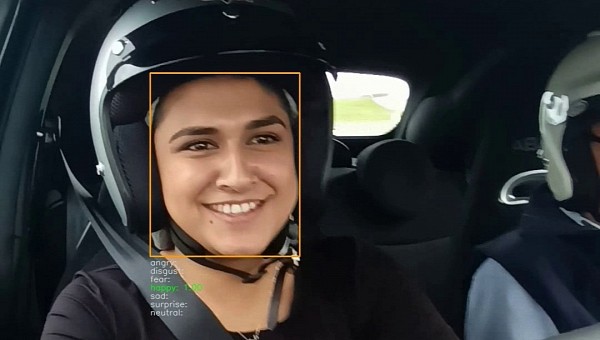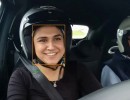Abarth is testing a world-first facial recognition technology to quantify if drivers and passengers are having fun in its vehicles. Now, this is just a prototype, and it was only tried in restricted conditions, so do not fear being watched by Big Brother when getting inside an Abarth next time. If there are cameras visible, they were not placed there by the manufacturer.
With that explanation out of the way, it is time to learn what Abarth has found after its trial of facial recognition tech to comprehend what the drivers and passengers from its sample group were feeling when they were driving or driven in one of the brand's models.
The trial was done with the help of Loughborough University, which had Dr. Dale Esliger conducting the test that had its practical aspects at the Mallory Park racetrack.
Those who participated in the trial got to drive an Abarth F595, 595 Esseesse, and 595 Competizione, and they were asked at first to do hot laps around the track.
Things moved on to precision driving tasks, as well as chase scenarios, and it was all in the name of science. When the participants were in the passenger seat, a professional driver was behind the wheel, just so everyone was safe the whole time.
Abarth has found that the most prominent feeling during a hot lap was happiness, which was experienced both behind the wheel (31.8 percent) and as a passenger (35.4 percent).
When the vehicle was being driven by a professional driver, there were short bursts of fear and shock (11.9 percent), which the team of scientists attributed to a thrilling track day experience. So, if you ever plan to thrill or shock your passengers, be sure to keep that feeling brief, not for the entire duration of the drive.
It is worth noting that all participants wore a Polar H10 Heart Rate Sensor around their chests, as well as an Empatica E4 on their wrists, so that the emotions visible on their faces could be correlated with their heart rate activity.
As you may be aware, if you are a bit happy or a bit scared, your heart rate will mildly go up, but getting too much out of either sensation might be bad for you.
Now, the Italians at Abarth are the first to have data obtained by one of the world's leading sport universities to back up their claims of bringing joy to their drivers and passengers on winding roads. To be fair, those who are most curious among us wonder what would the least entertaining vehicle to drive around a track be.
The trial was done with the help of Loughborough University, which had Dr. Dale Esliger conducting the test that had its practical aspects at the Mallory Park racetrack.
Those who participated in the trial got to drive an Abarth F595, 595 Esseesse, and 595 Competizione, and they were asked at first to do hot laps around the track.
Things moved on to precision driving tasks, as well as chase scenarios, and it was all in the name of science. When the participants were in the passenger seat, a professional driver was behind the wheel, just so everyone was safe the whole time.
Abarth has found that the most prominent feeling during a hot lap was happiness, which was experienced both behind the wheel (31.8 percent) and as a passenger (35.4 percent).
When the vehicle was being driven by a professional driver, there were short bursts of fear and shock (11.9 percent), which the team of scientists attributed to a thrilling track day experience. So, if you ever plan to thrill or shock your passengers, be sure to keep that feeling brief, not for the entire duration of the drive.
It is worth noting that all participants wore a Polar H10 Heart Rate Sensor around their chests, as well as an Empatica E4 on their wrists, so that the emotions visible on their faces could be correlated with their heart rate activity.
As you may be aware, if you are a bit happy or a bit scared, your heart rate will mildly go up, but getting too much out of either sensation might be bad for you.
Now, the Italians at Abarth are the first to have data obtained by one of the world's leading sport universities to back up their claims of bringing joy to their drivers and passengers on winding roads. To be fair, those who are most curious among us wonder what would the least entertaining vehicle to drive around a track be.








